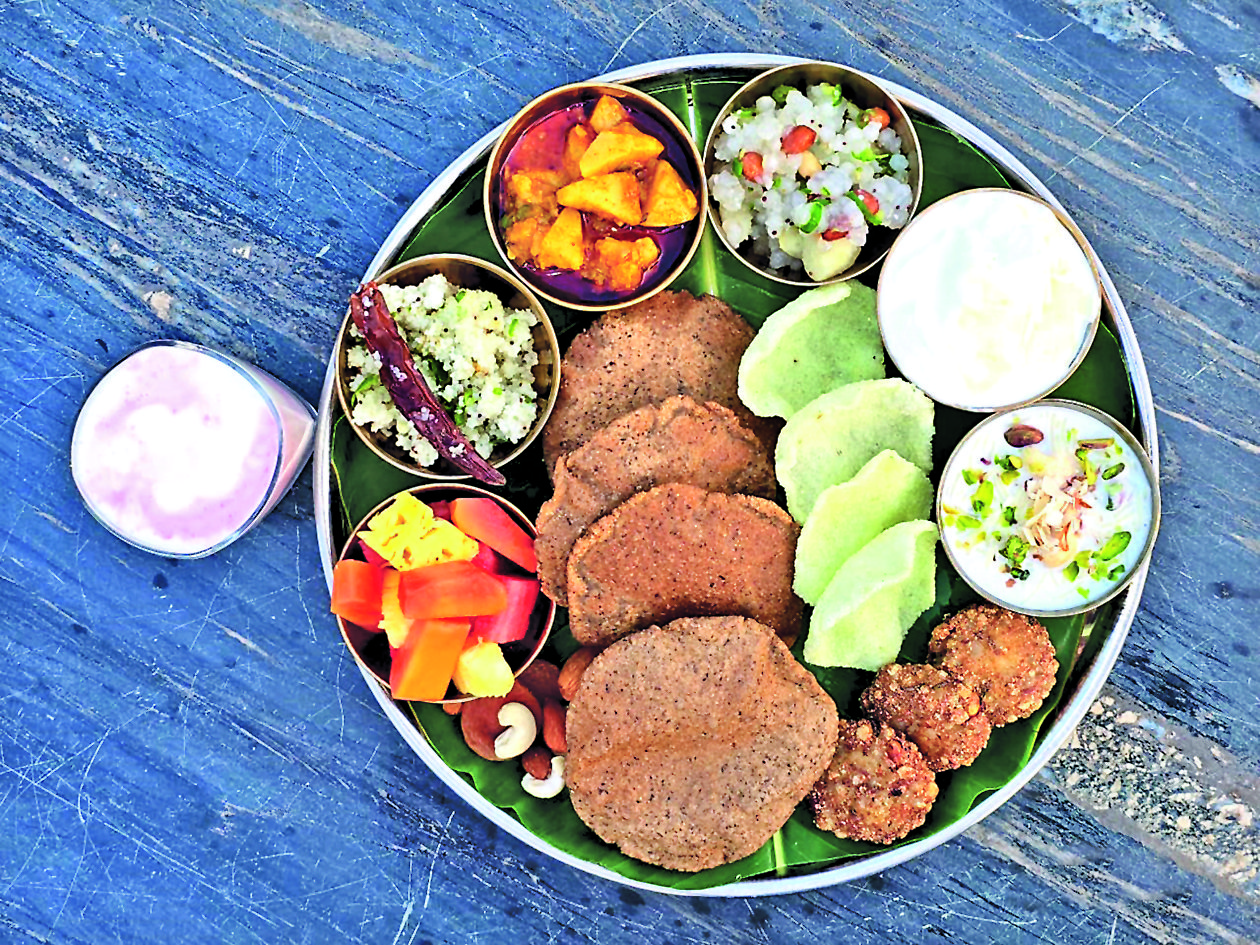
Fasting during Navratri is a key part of the nine-day festival, traditionally observed from sunrise to sunset. We speak to experts to understand more.
Fasting Food
When breaking the Navratri fast, it is important to avoid non-vegetarian food, including eggs, as well as onions and garlic, which are believed to interfere with spiritual practices. The diet should be strictly ‘sattvic’ which means plant-based, pure and energy-giving. Light, easily digestible meals are recommended. Opt for non-grain alternatives such as kuttu ka atta (buckwheat flour), singhare ka atta (water chestnut flour), and Samvat rice (barnyard millet), also known as vrat ka chawal. “Eat fresh vegetables such as pumpkin, potato, bottle gourd and tomatoes. Fresh fruits like apples, bananas, papayas, pomegranates, and berries are ideal during this period. Dairy products such as milk, yogurt, buttermilk, paneer, and ghee are commonly consumed, either on their own or in dishes like raita. For snacks, makhana (fox nuts), almonds, walnuts, cashews, and dates are popular options. Sabudana (tapioca pearls) is widely used to make dishes like sabudana khichdi, sabudana vada and sabudana kheer. Instead of regular table salt, rock salt (sendha namak) is used for seasoning during the fast,” says Sharma.
Do It Right
Navratri, a joyous nine-day Hindu festival, brings with it the excitement of savouring a wide array of delightful and unique foods. From fragrant dishes to wholesome, traditional recipes, food becomes an essential part of the celebration, believed to nourish both body and spirit. Chef Supreet Ghai, Director of Culinary at ibis & ibis Styles, says, “The practice of fasting, or Navratri Vrat, centres around abstaining from certain foods while embracing a diet rich in sattvic, light, and easily digestible meals. These culinary traditions not only align with spiritual practices but are also rooted in the wisdom of promoting physical health. Saatvik foods—such as fresh fruits, vegetables, nuts, and grains—allow the digestive system to rest and rejuvenate, offering a natural cleanse for the body. Beyond religious beliefs, the emphasis on clean, simple ingredients during Sharad Navratri brings balance and energy, supporting overall
wellness.” Many devotees look forward to the
special Navratri dishes, prepared with love and devotion, that provide nourishment and help detoxify the body. The deliciousness of these traditional foods enhances the festive experience, bringing joy while contributing to better health.
Seasonal Cues
Every meal in Navratri is an ode to purity, crafted with respect to the traditions and art of fasting yet bursting with flavour that is anything but restrictive. Chef Vividh Patil, Sofitel Mumbai BKC says, “At its heart, the festival of Navratri is a time for spiritual reflection and renewal, with the tradition of fasting being a vital part of this experience. It allows one to cleanse not just the body, but also the mind, creating space for positivity and practising gratitude. Fasting during Navratri is a moment of mindfulness, where the food we consume is simple yet sacred. It is about grounding oneself in tradition, while also embracing the opportunity for self-discipline and balance. The art of fasting also benefits our bodies in detoxing as we transit from the monsoons to autumn.”
— Akshraj Jodha,
Executive Chef, ITC GrandBharat
Sharkarkandhi
ki Kheer
(Courtesy Akshraj Jodha,
Executive Chef, ITC Grand Bharat)
• Sharkarkandhi (sweet potato) 500 grams
• Milk 2 litres
• Saffron A Pinch
• Sugar 150 gm
• Cardamom 4 pods
For Garnish Tempering
• Ghee 30 ml
• Chopped almond 15 gm
• Chopped Cashews 15 gm
• Sliced Pistachios4 gm
• Boil the milk with cardamom and reduce it to 1600 ml.
• Then remove the cardamom pods. Add peeled and grated sweet potato.
• Cook the potatoes on a simmering heat.
• Once cooked the milk will reduce to 800 ml then add sugar and saffron.
• Pour it in the serving bowls and let it cool.
• Heat a pan and add the ghee.
• Remove the pan from the heat and then add the nuts, let them get a rich brown colour.
• Then pour the hot ghee on the cold kheer and garnish it with sliced pistachios.
SABUDANA VADA
(Courtesy: Thirumurugan B, Exec. Chef, Sterling
Kodai Lakeview)
Ingredients
• Sabudana 250 gm
• Potato 200 gm
• Peanut 200 gm
• Senda namak to taste
• Green chilli 5 gm
• Cumin seed 6 gm
• Coriander leaves 10 gm
• Oil for frying
• Cut the chilli into small pieces and finely chop the coriander leaves.
• Boil the potatoes and cut them into small pieces.
• Roast the peanuts lightly
• Mix the sabudana, potato, peanuts, senda namak, green chilli, cumin seed and coriander leaves.
• Make small balls of all the mixed ingredients and then flatten them like tikki.
• Heat oil to medium and fry these tikkis till crisp from the outside.
• Garnish with some chopped coriander
and serve.
